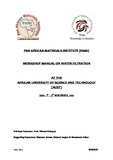Browsing by Title
Now showing items 4738-4757 of 4783
-
What to Read: A Biased Guide to AI Literacy for the Beginner
(MIT Artificial Intelligence Laboratory, 1972-11)This note tries to provide a quick guide to AI literacy for the beginning AI hacker and for the experienced AI hacker or two whose scholarship isn't what it should be. most will recognize it as the same old list of classic ...
-
What's in a Tune
(1974-11-01)The work reported here began with two fundamental assumptions: 1) The perception of music is an active process; it involves the individual in selecting, sorting, and grouping the features of the phenomena before her. ...
-
What's What
(MIT Artificial Intelligence Laboratory, 1971-03)An outline of the modules used in the copy demonstration, the reasons for doing robotics, and some possible directions for further work.
-
-
Why are There so Few Female Computer Scientists?
(1991-08-01)This report examines why women pursue careers in computer science and related fields far less frequently than men do. In 1990, only 13% of PhDs in computer science went to women, and only 7.8% of computer science ...
-
Why Classical Finite difference Approximations fail for a singularly perturbed System of Convection-Diffusion Equations
(2016-06-07)We consider classical Finite Difference Scheme for a system of singularly perturbed convection-diffusion equations coupled in their reactive terms, we prove that the classical SFD scheme is not a robust technique for solving ...
-
Why Classical Finite difference Approximations fail for a singularly perturbed System of Convection-Diffusion Equations
(2016-06-07)We consider classical Finite Difference Scheme for a system of singularly perturbed convection-diffusion equations coupled in their reactive terms, we prove that the classical SFD scheme is not a robust technique for solving ...
-
Why Conniving is Better than Planning
(1972-02-01)A higher level language derives its great power form the fact that it tends to impose structure on the problem solving behavior for the user. Besides providing a library of useful subroutines with a uniform calling ...
-
Why Conniving is Better than Plannng
(1972-04-01)This paper is a critique of a computer programming language, Carl Hewitts PLANNER, a formalism designed especially to cope with the problems that Artificial Intelligence encounters. It is our contention that the ...
-
Why Do We See Three-dimensional Objects?
(1992-06-01)When we look at certain line-drawings, we see three-dimensional objects. The question is why; why not just see two-dimensional images? We theorize that we see objects rather than images because the objects we see are, ...
-
Why Stereo Vision is Not Always About 3D Reconstruction
(1993-07-01)It is commonly assumed that the goal of stereovision is computing explicit 3D scene reconstructions. We show that very accurate camera calibration is needed to support this, and that such accurate calibration is difficult ...
-
Wicked Problems and Gnarly Results: Reflecting on Design and Evaluation Methods for Idiosyncratic Personal Information Management Tasks
(2008-02-10)This paper is a case study of an artifact design and evaluation process; it is a reflection on how right thinking about design methods may at times result in sub-optimal results. Our goal has been to assess our decision ...
-
Wide-Area Egomotion Estimation from Known 3D Structure
(2006-01-09)We describe an algorithm that takes as inputs a coarse3D model of an environment, and a video sequence acquiredwithin the environment, and produces as output an estimateof the camera s 6-DOF egomotion expressed in the ...
-
Wireless Sensor Networks for Environmental Monitoring Applications
(2016-08-16)After many years of rigorous research and development in wireless sensor network (WSN) technology with numerous responses to innovative applications, WSNs still have some interesting unanswered questions. In this thesis ...
-
WIRElist
(1969-01-01)This memo describes a design aid used for the automatic production of wirelists for machine or hand wiring of wire-cards.
-
Witt groups of complex varieties
(University of CambridgeDepartment of Pure Mathematics and Mathematical StatisticsTrinity Hall, 2011-07-12)The thesis Witt Groups of Complex Varieties studies and compares two related cohomology theories that arise in the areas of algebraic geometry and topology: the algebraic theory of Witt groups, and real topological K-theory. ...
-
A workflow for geocoding South African addresses
(University of Cape TownFaculty of ScienceDepartment of Computer Science, 2015)There are many industries that have long been utilizing Geographical Information Systems (GIS) for spatial analysis. In many parts of the world, it has gained less popularity because of inaccurate geocoding methods and a ...
-
-
Workshop on the Design and Control of Dextrous Hands
(1982-04-01)The Workshop for the Design and Control of Dexterous Hands was held at the MIT Artificial Intelligence Laboratory on November 5-6, 1981. Outside experts were brought together to discuss four topics: kinematics of hands, ...
-
World Wide Web Without Walls
(2007-08-24)Today's Web is built upon a particular symbiotic relationship betweensites and users: the sites invest capital to create and market a setof features, and users gain access to the sites often in exchange fortheir data (e.g., ...




